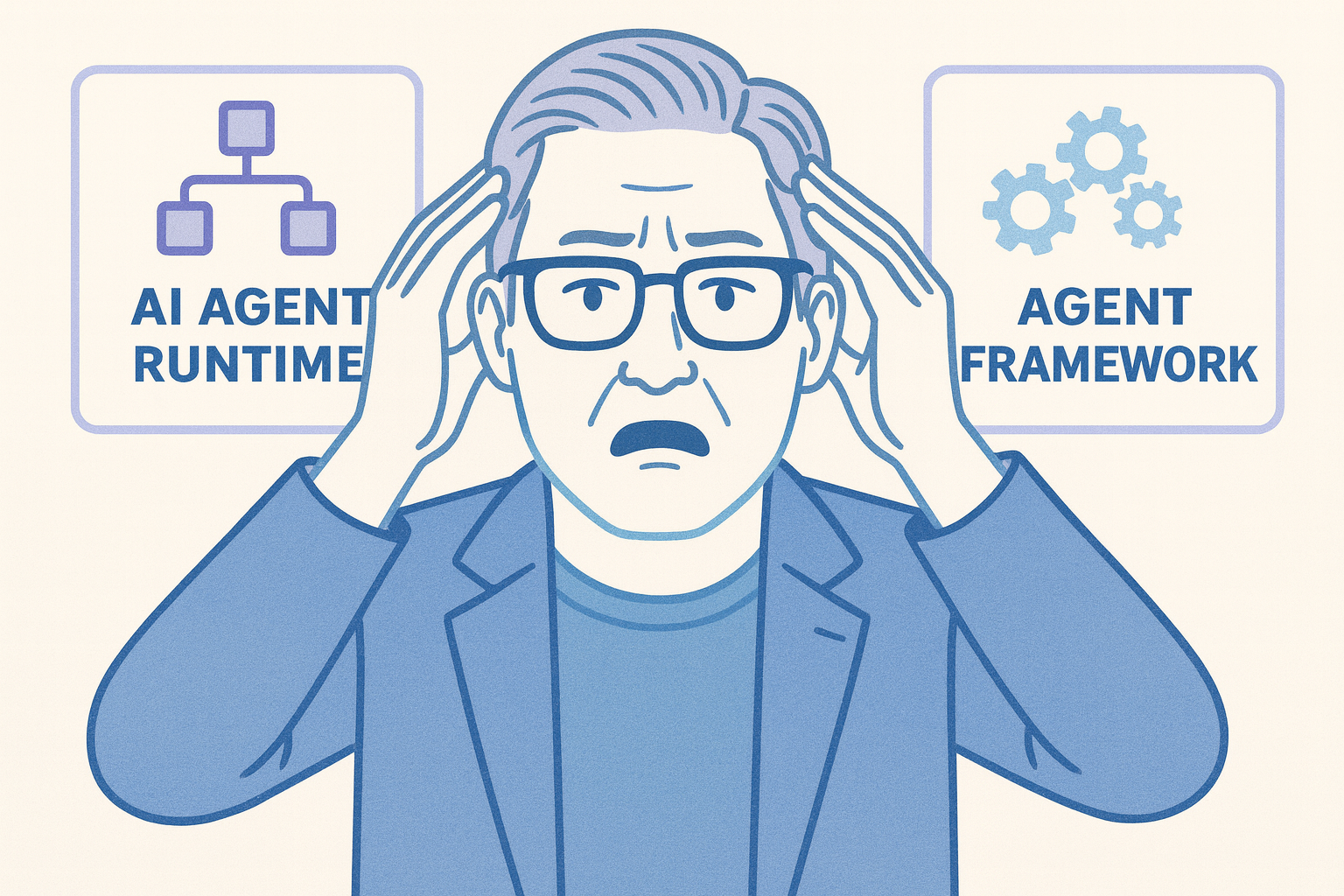In the rapidly evolving world of AI “AI agent runtimes have emerged as environments where AI agents can be freely executed—designed, tested, deployed, and orchestrated—to achieve high-value automation. When discussing the development and deployment of AI agents, runtimes are often confused with agent frameworks. While they may sound similar, they serve distinct purposes in the AI ecosystem. The unique capabilities of runtimes and frameworks can make it more efficient to scale AI agents within an organization.
Overview of AI Agent Runtimes and Frameworks
AI agent runtimes provide the infrastructure for executing AI agents. Runtimes handle orchestration, state management, security, and integration. AI agent frameworks focus on building agents and offer tools for reasoning, memory, and workflows. Frameworks most often need pairing with a separate runtime for production deployment.
A full lifecycle solution combines runtimes and frameworks, enabling end-to-end management from inception through ongoing runtime operations, maintenance, and evolution.
Understanding AI Agent Runtime
An AI agent runtime is the execution environment where AI agents operate. It’s the infrastructure or platform that enables agents to run, process inputs, execute tasks, and deliver outputs in real-time or near-real-time. A runtime is the engine that powers the functionality of AI agents, ensuring they can interact with users, APIs, or other systems safely and efficiently.
Key characteristics of AI agent runtimes:
- Execution-focused: Runtimes provide the computational resources, memory management, and processing capabilities needed to run AI agents.
- Environment-specific: Runtimes handle tasks like scheduling, resource allocation, and communication with external systems (like cloud services, databases, or APIs).
- Highly Scalable: Runtimes ensure the agent can handle varying workloads, from lightweight tasks to complex, multi-step processes.
Examples of AI agent runtimes:
- Cloud-based platforms like AWS Lambda for serverless AI execution
- Kubernetes for containerized AI workloads
- Dedicated runtime environments like those provided by xAI for running Grok models
- No-code platforms like OneReach.ai’s Generative Studio X (GSX)serve as full lifecycle solutions, combining runtimes and frameworks—to orchestrate multimodal AI agents across channels like Slack, Teams, email and various voice channels
Runtimes enable real-time automation and workflow management. An AI agent runtime manages the compute resources and data pipelines needed for AI agents to process user queries and generate personalized responses.
Understanding AI Agent Frameworks
An AI agent framework is a set of tools, libraries, and abstractions designed to simplify the development, training, and deployment of AI agents. It provides developers with pre-built components, APIs, and templates to create custom AI agents without starting from scratch.
Key characteristics of AI agent frameworks:
- Development-focused: Frameworks streamline the process of building, configuring, and testing AI agents.
- Modular: Frameworks offer reusable components like natural language processing (NLP) modules, decision-making algorithms, and integration tools for connecting to external data sources.
- Flexible: Frameworks allow developers to define the agent’s behavior, logic, and workflows, with support for specific use cases ranging from chatbots to task automation to multi-agent systems.
Examples of AI Agent Frameworks:
- Frameworks like LangChain for building language model-powered agents
- Rasa for conversational AI
- AutoGen for multi-agent collaboration
A developer might use a framework like LangChain to design an AI agent that retrieves data from a knowledge base, processes it with a large language model, and delivers a response, while abstracting away low-level complexities.
Key differences between agent runtimes and agent frameworks
How Runtimes and Frameworks Fit Together
AI agent runtimes and frameworks are complementary. Frameworks are used to design and build AI agents, defining their logic, capabilities, and integrations. Once agents are developed, they are deployed into a runtime environment where they can operate at scale, processing real-world inputs, and interact with users or systems. For example, an AI agent built using LangChain (framework) might be deployed on a cloud-based runtime like AWS or xAI’s infrastructure to handle user queries in production.
Runtimes often include or integrate framework-like features to streamline the process. OneReach.ai’s GSX platform acts as a runtime for orchestrating AI agents but incorporates no-code building tools that function similarly to a framework, allowing users to quickly design, test, and deploy agents without deep coding.
Other pairings include LangChain with AWS Lambda, where LangChain handles agent logic and AWS provides the scalable runtime, as well as Rasa (for conversational flows) with Kubernetes (for containerized execution).
Integrated vs. Separate A Philosophical Distinction Between Approaches
Not all runtimes include agent building features. Some, like AWS Lambda or Kubernetes, are pure execution environments without built-in tools for designing agent logic, requiring separate frameworks for development. Others, such as GSX (OneReach.ai), integrate no-code interfaces for creating and customizing agents directly into the runtime, blending the two elements.
This distinction reflects a philosophical position in AI design: Should building and deployment be tightly integrated into a single platform, or kept separate for modularity? Proponents of separation argue it allows for greater flexibility—developers can mix and match best-in-class frameworks with specialized runtimes, fostering innovation and customization. However, integrating both offers significant advantages, particularly for companies without highly trained teams.
By controlling both building and deployment, integrated platforms reduce complexity, minimize handoffs between tools, and ensure seamless transitions from design to production. This is especially beneficial for non-technical users or smaller organizations in sectors like HR or customer support, where quick setup, no-code accessibility, and reliable orchestration across channels enable rapid AI adoption without the need for expert developers or data scientists.
Estimated Project Time and Resources
For separate frameworks and runtimes (e.g., LangChain + AWS Lambda), building a basic AI agent might take 4-12 weeks, requiring 1-3 skilled developers (with Python and AI expertise) and potentially $10,000-$50,000 in initial costs (salaries, cloud fees, and setup). This suits teams focused on customization but demands more upfront investment in skills and integration. Integrated platforms like OneReach.ai can reduce this to days or 1-4 weeks for prototyping and deployment, often needing 1-2 non-technical users or business analysts, with costs around $500-$5,000 monthly (subscriptions) plus minimal setup—ideal for faster ROI in resource-constrained environments.
Pros and Cons of All-in-One Solutions
Pros and Cons of Frameworks + Runtimes
Can You Choose One Over the Other?
The choice between an AI agent runtime and a framework depends on your project’s stage and needs. Frameworks excel in the development phase, offering flexibility for custom logic, experimentation, and integration with specific AI models or tools—ideal when you need granular control over agent behavior. However, they require more coding expertise and don’t handle production-scale execution on their own, often leading to longer timelines (e.g., weeks for development) and higher resource demands (e.g., dedicated engineering teams).
Runtimes shine in deployment and operations, providing the infrastructure for reliable, scalable performance, including resource management and real-time processing. They are better for ensuring agents run efficiently in live environments but may lack the depth for initial agent design unless they include integrated building features.
Platforms like OneReach.ai blur the lines by combining runtime capabilities with framework-style no-code tools, making them suitable for end-to-end workflows but potentially less customizable for advanced users—while cutting project time to hours or days and reducing the need for specialized skills.
In essence, use a framework if your focus is innovation and prototyping; opt for a runtime if reliability and scalability in production are paramount. For integrated solutions, choose platforms that handle both to simplify processes for less technical teams, with shorter timelines and lower resource barriers.
Who Should Choose One vs. the Other?
Choose a Framework if you’re a developer, AI engineers, and researchers building custom agents from scratch are likely to use frameworks. LangChain and AutoGen are perfect for teams with coding skills who need modularity and want to iterate on agent intelligence—like R&D or startups experimenting with novel AI applications—but entail 4-12 weeks and engineering resources for a full project.
Operations teams, IT leaders, and enterprises focused on deployment and maintenance should gravitate toward runtimes. OneReach.ai and AWS Lambda suit non-technical users and large organizations prioritizing quick orchestration, automation across channels, and handling high-volume tasks without deep development overhead—especially in sectors like HR, finance, or customer support where speed to production (days to weeks) matters more than customization. Integrated runtimes are ideal for companies lacking highly trained teams, as they provide end-to-end control for easier adoption with reduced time and costs.
For most companies—particularly mid-to-large enterprises without deep AI expertise or those prioritizing speed and reliability—an all-in-one AI agent runtime with building capabilities spanning the full lifecycle is likely the best solution. This approach simplifies deployment, reduces hidden costs, and ensures scalability and security out-of-the-box, enabling faster ROI (e.g., setup in hours vs. months). All-in-one platforms suit common use cases like workflow automation or chatbots.
Companies with strong technical teams that are experienced in AI projects and with high customization requirements might pair a framework with a runtime for more flexibility, with higher complexity and risk. Pilot projects with tools like LangGraph (full lifecycle) or CrewAI (framework) can help organizations decide what will best suit their needs.
Conclusion
In summary, AI agent frameworks are about building the agent—providing the tools to create its logic and functionality. AI agent runtimes are about running the agent, ensuring it has the resources and environment to perform effectively. Platforms like OneReach.ai demonstrate how runtimes can incorporate framework elements for a more integrated experience, highlighting the philosophical debate on separation vs. integration. Understanding this distinction is crucial for developers and organizations looking to create and deploy AI agents efficiently.
For those interested in exploring AI agent development, frameworks like LangChain or Rasa are great starting points, while platforms like AWS or xAI’s API services offer robust runtimes for deployment.








